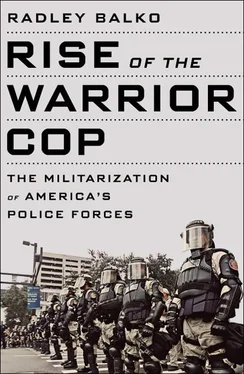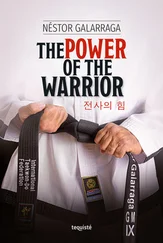Of course, Gates had no intention of using APCs for rescue. He was growing frustrated with the problems his SWAT teams encountered when breaking into fortified crack houses. They had tried ripping doors off their hinges by attaching them to tow trucks. That took too long, giving suspects too much time to destroy evidence. They had tried blasting locks open with specialized explosives called shape chargers. But those could throw off shrapnel and debris, making them dangerous for the raiding cops. Then one of Gates’s subordinates came to him with a new idea: they could attach a battering ram to the front of one of the armored personnel carriers. So Gates had one of the vehicles outfitted with a battering ram and found some abandoned houses slated for demolition that the SWAT team could use for practice.
On this particular night in February 1985, Gates planned to unveil the new weapon on a suspected crack house in a relatively nice Pacoima neighborhood. Gates even invited along a couple of photographers to document his latest innovation for the archives.
After stopping a few blocks away to attach the ram, the APC and the SWAT team approached the targeted house, this time with no less than the city’s police chief riding along. The SWAT team took position. The APC revved up some momentum, hopped the driveway, and punched a hole in the side of the house. It then moved in and out of the hole several times to widen it. (Yes, the symbolism is inescapable.) Once the hole was large enough, the vehicle pulled out, and the SWAT team pounced. Inside, they found two women and three children eating ice cream. No drugs, though police later claimed to have found “traces” of cocaine and items they said were drug paraphernalia. Meanwhile, as the APC withdrew from the house, it hit a patch of ice. The driver lost control, which sent the driver, Gates, and the chief’s new toy careening into the side of a Cadillac parked in the driveway. “It was not our shining hour,” Gates would later write. 16
Gates insisted that they had the correct house—he writes in his autobiography that the drug dealer had merely run out of crack and had gone to get more. But it sure didn’t seem like a crack house. Crack houses were usually filthy, heavily fortified, and furnished with the sorts of things necessary to make and sell crack. (Nancy Reagan once famously visited an alleged crack house and remarked, “Where is the furniture?”) Gates had raided a home. It had furniture, a fireplace, a den. More problematic for Gates, it also contained two women and three children. Eating ice cream.
The media and civil liberties advocates piled on. That only made Gates more defiant. He vowed to take his new battering ram to “every single fortified rock house in this town!” In his autobiography, Gates argues that the ram had a deterrent effect, that “it frightened even the hard-core pushers to imagine that at any moment a device was going to put a big hole in their place of business, and in would march SWAT, scattering flash-bangs and scaring the hell out of everyone.” 17
The ACLU took Gates to court over the ram. While LAPD officials insisted at the time that they weren’t backing down, the department discontinued its use during litigation. By the time the California Supreme Court resolved the case in 1987, the ram had basically been retired—at least for the time being. The court found the ram to be so excessive as to violate the Fourth Amendment requirement that searches be reasonable, and it ruled that prior to each raid the LAPD would need to get special permission from a judge before using a battering ram. (In the same case, the court also ruled that city police did not need a judge’s permission to use flash-bang grenades.)
Gates’s antics aside, the battering ram at least showed that as of 1985 we were still capable of finding that some drug war tactics went too far. It wasn’t just the California Supreme Court. Public opinion polls also showed strong opposition to the ram. The ram was only used four times before community outrage compelled the department to stop. Gates had been forced to “demilitarize” his APCs by painting them blue and calling them “rescue vehicles” in order to get the city’s police commission to approve them. City officials were still wary about using battle gear on the streets of Los Angeles. A state supreme court was still capable of finding at least some militaristic police tactics unreasonable under the Fourth Amendment. We still had some limits.

UNFORTUNATELY, THAT WOULDN’T LAST. AT THE NATIONAL level, the once-separate trends of militarization and the war on drugs continued to converge. On April 8, 1986, President Reagan signed National Security Decision Directive 221, which designated illicit drugs a threat to US national security. In addition to adding to the drug interdiction responsibilities of agencies like the CIA and the State Department, the directive also instructed the US military “to support counter-narcotics efforts more actively,” including providing assistance to law enforcement agencies “in the planning and execution of large counter-narcotics operations,” “participat[ing] in coordinated interdiction programs,” engaging in combined exercises with civilian law enforcement agencies, and training and helping foreign militaries conduct antidrug operations. The declaration put pot, cocaine, and heroin at nearly the same class of enemy as any nation against whom the United States had fought a conventional war.
There were a few other policies enacted toward the end of the Reagan years that were little noticed at the time but further cleared the way for mass militarization of civilian police agencies. One of the most destructive was a massive influx of federal money to local police departments solely for the purpose of drug policing. The money could be used to start, fund, and maintain SWAT teams, to expand narcotics units, or to pay cops overtime for doing extra drug investigations. Taken with the potential bounty available in asset forfeiture, police departments across the country were now heavily incentivized to devote more time, personnel, and aggression to drug policing and less to investigating murders, rapes, and robberies. There was no money in investigating crimes with actual victims. Drug investigations could pay for themselves—and often brought in additional revenue.
Another new policy was buried in the National Defense Appropriation Act for Fiscal Year 1987. It instructed the National Guard to provide full cooperation with local and federal law enforcement agencies in drug investigations. The law gave the Guard its first budget for counterdrug operations. In 1989 Congress expanded the budget to $60 million. In some places, Guard troops were now even conducting searches and making arrests. But in the short term, the main effect of the new law was to give local law enforcement agencies access to National Guard aircraft.
The other major new policy came in 1987, when Congress ordered the secretary of Defense and the US attorney general to notify local law enforcement agencies each year about the availability of surplus military equipment they could obtain for their departments. The pre-election GOP crime bill of 1968 had already authorized the military to share equipment with local police agencies. But the 1987 law was more proactive. It established an office in the Pentagon specifically to facilitate transfers of war gear to civilian law enforcement. Congress even set up an 800 number that sheriffs and police chiefs could call to see what was available, and it ordered the General Services Administration to work with the Pentagon to produce a catalog from which police agencies could make their wish lists.
It had not been that long since Darryl Gates had been compelled to hide from his own police commission the fact that he had obtained a military-issue armored personnel carrier, or since he had had to have his mayor call the US secretary of Defense to get permission to use a grenade launcher. Congress had now authorized—encouraged, really—the transfer of vehicles, armor, and weapons (along with more mundane items like office furniture) that had been designed for use on a battlefield against enemy combatants to be used on American streets, in American neighborhoods, against American citizens.
Читать дальше













